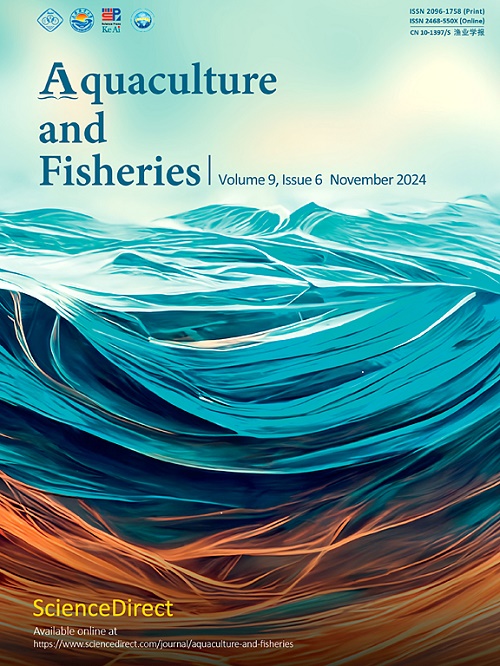以大头鲤为主的水库中甲壳类浮游动物的变化模式
Q1 Agricultural and Biological Sciences
引用次数: 0
摘要
在以鳙鱼为主的水库中,甲壳类浮游动物与(浮游)鱼类之间的关系尚未得到很好的澄清,因为以往的研究大多是在温带湖泊和/或浅水湖泊中进行的。这些研究的局限性在于,甲壳类浮游动物既缺乏大型食草动物,如大头鱼,也缺乏浮游动物避免浮游鱼类捕食的垂直迁徙空间。水库是人类日益重要的饮用水源,对鳙鱼为主的水库中浮游动物与鱼类的关系有更好的认识,是水库环境管理的重要基础。为了实现这一目标,我们调查了浙江塘浦水库浮游动物的结构和变化,并研究了浮游动物与鱼类的关系。结果表明,甲壳类浮游动物种类丰富。共检出甲壳类浮游动物59种,其中桡足类33种,枝海类26种,以大型种为主。浮游甲壳类动物的密度在15.5 ~ 68.5 ind./L之间变化,年平均密度为24.9±14.4 ind./L,在以浮游鱼类为主的深层水库中,浮游动物的密度高于许多鱼类较少的水库或浅层湖泊。浮游动物和鱼类的垂直分布也存在差异,在一年中的许多月份,浮游动物在5 m - 10 m,鱼类在0.5 m - 10 m。这可以很好地解释为什么在鳙鱼为主的水库中浮游动物没有减少,也没有被小物种占主导地位,因此我们得出结论,在鳙鱼为主的深层水库生态系统中,浮游动物可能不会与浮游鱼直接竞争浮游植物,而是通过向更深的水层分布或迁移,在更深的水层浮游植物和浮游鱼类粪便产生的碎屑上生存和繁衍。因此,可能能够与浮游鱼类协调改善水质。本文章由计算机程序翻译,如有差异,请以英文原文为准。
Variation pattern of crustacean zooplankton in a bigheaded carps-dominated reservoir
The relationship between crustacean zooplankton and (planktivorous) fish has not been well clarified in bigheaded-carps-dominated reservoirs, for most of the past studies to explore that kind of knowledge above are often obtained from the studies in temperate lakes and/or shallow lakes. The limitation of these studies is that crustacean zooplankton lack of either large grazers such as the bigheaded carps or the vertical migrating space for zooplankton to avoid predation by planktivorous fish. Reservoirs are more and more important drinking water source for human consumption, so a better environmental management of reservoirs will rely on a better understanding on the relationship between zooplankton and fish in bigheaded carp dominated reservoirs. To help reach that goal, we investigated the structure and variation of zooplankton and studied the relationship between zooplankton and fish in Tangpu reservoir, Zhejiang province, China. Our results showed that the species of crustacean zooplankton were richer. A total of 59 species of crustacean zooplankton were detected, including 33 species of copepods and 26 species of cladoceran, and dominated by larger species. The density of crustacean zooplankton varied between 15.5–68.5 ind./L with an annual average density of 24.9 ± 14.4 ind./L, it is higher in this planktivorous carps dominated deep reservoir than in many carp-less-dominated reservoirs or in shallow lakes. We also found that zooplankton and fish had a differential vertical distribution, i.e., zooplankton occurred 5 m–10 m but fish occurred 0.5 m–10 m in many months of the year. This could well explain why zooplankton were not reduced and not dominated by small species in bigheaded carps dominated reservoir, so we concluded that in planktivorous carp dominated deep reservoir ecosystems, zooplankton might not compete directly with planktivorous carps for phytoplankton, instead by distributing or migrating to deeper water column, they may survive and thrive on the phytoplankton in deeper column and the detritus resulted from the feces of planktivorous fish, thus might be able to coordinately improve water quality with planktivorous fish.
求助全文
通过发布文献求助,成功后即可免费获取论文全文。
去求助
来源期刊

Aquaculture and Fisheries
Agricultural and Biological Sciences-Aquatic Science
CiteScore
7.50
自引率
0.00%
发文量
54
审稿时长
48 days
期刊介绍:
 求助内容:
求助内容: 应助结果提醒方式:
应助结果提醒方式:


